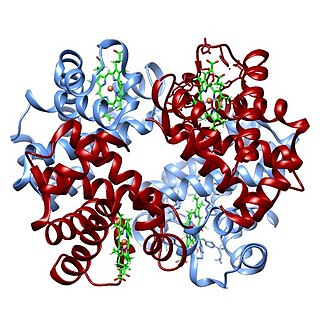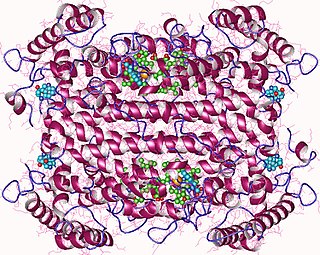The Ferrier rearrangement is an organic reaction that involves a nucleophilic substitution reaction combined with an allylic shift in a glycal. It was discovered by the carbohydrate chemist Robert J. Ferrier.

2,3-Sigmatropic rearrangements are a type of sigmatropic rearrangements and can be classified into two types. Rearrangements of allylic sulfoxides, amine oxides, selenoxides are neutral. Rearrangements of carbanions of allyl ethers are anionic. The general scheme for this kind of rearrangement is:

The oxygen–hemoglobin dissociation curve, also called the oxyhemoglobin dissociation curve or oxygen dissociation curve (ODC), is a curve that plots the proportion of hemoglobin in its saturated (oxygen-laden) form on the vertical axis against the prevailing oxygen tension on the horizontal axis. This curve is an important tool for understanding how our blood carries and releases oxygen. Specifically, the oxyhemoglobin dissociation curve relates oxygen saturation (SO2) and partial pressure of oxygen in the blood (PO2), and is determined by what is called "hemoglobin affinity for oxygen"; that is, how readily hemoglobin acquires and releases oxygen molecules into the fluid that surrounds it.

2,3-Bisphosphoglyceric acid (2,3-BPG), also known as 2,3-diphosphoglyceric acid (2,3-DPG), is a three-carbon isomer of the glycolytic intermediate 1,3-bisphosphoglyceric acid (1,3-BPG).

Bisphosphoglycerate mutase is an enzyme expressed in erythrocytes and placental cells. It is responsible for the catalytic synthesis of 2,3-Bisphosphoglycerate (2,3-BPG) from 1,3-bisphosphoglycerate. BPGM also has a mutase and a phosphatase function, but these are much less active, in contrast to its glycolytic cousin, phosphoglycerate mutase (PGM), which favors these two functions, but can also catalyze the synthesis of 2,3-BPG to a lesser extent.

Indoleamine-pyrrole 2,3-dioxygenase (IDO or INDO EC 1.13.11.52) is a heme-containing enzyme physiologically expressed in a number of tissues and cells, such as the small intestine, lungs, female genital tract or placenta. In humans is encoded by the IDO1 gene. IDO is involved in tryptophan metabolism. It is one of three enzymes that catalyze the first and rate-limiting step in the kynurenine pathway, the O2-dependent oxidation of L-tryptophan to N-formylkynurenine, the others being indolamine-2,3-dioxygenase 2 (IDO2) and tryptophan 2,3-dioxygenase (TDO). IDO is an important part of the immune system and plays a part in natural defense against various pathogens. It is produced by the cells in response to inflammation and has an immunosuppressive function because of its ability to limit T-cell function and engage mechanisms of immune tolerance. Emerging evidence suggests that IDO becomes activated during tumor development, helping malignant cells escape eradication by the immune system. Expression of IDO has been described in a number of types of cancer, such as acute myeloid leukemia, ovarian cancer or colorectal cancer. IDO is part of the malignant transformation process and plays a key role in suppressing the anti-tumor immune response in the body, so inhibiting it could increase the effect of chemotherapy as well as other immunotherapeutic protocols. Furthermore, there is data implicating a role for IDO1 in the modulation of vascular tone in conditions of inflammation via a novel pathway involving singlet oxygen.
In enzymology, a vitamin-K-epoxide reductase (warfarin-insensitive) is an enzyme that catalyzes the chemical reaction

In enzymology, tryptophan 2,3-dioxygenase (EC 1.13.11.11) is a heme enzyme that catalyzes the oxidation of L-tryptophan (L-Trp) to N-formyl-L-kynurenine, as the first and rate-limiting step of the kynurenine pathway.

GYKI 52466 is a 2,3-benzodiazepine that acts as an ionotropic glutamate receptor antagonist, which is a non-competitive AMPA receptor antagonist (IC50 values are 10-20, ~ 450 and >> 50 μM for AMPA-, kainate- and NMDA-induced responses respectively), orally-active anticonvulsant, and skeletal muscle relaxant. Unlike conventional 1,4-benzodiazepines, GYKI 52466 and related 2,3-benzodiazepines do not act on GABAA receptors. Like other AMPA receptor antagonists, GYKI 52466 has anticonvulsant and neuroprotective properties.
The 2007 WGC-CA Championship was a golf tournament that was contested from March 22–25 over the Blue Monster Course at Doral Golf Resort & Spa in Doral, Florida. It was the eighth WGC-CA Championship tournament, and the second of three World Golf Championships events held in 2007. It was the first tournament under the sponsorship of CA, Inc. and took the place of the Ford Championship at Doral on the PGA Tour schedule.
The 2009 WGC-CA Championship was a golf tournament that was contested from March 12–15 at Doral Golf Resort & Spa in Doral, Florida. It was the tenth WGC-CA Championship tournament, and the second of four World Golf Championships events staged in 2009.

2,3-Methylenedioxyamphetamine (2,3-MDA) or ORTHO-MDA is an amphetamine derivative which is mentioned in PIHKAL as a fairly potent and long-lasting stimulant drug, but with little or none of the entactogenic effects associated with its better-known structural isomer MDA.
The [2,3]-Wittig rearrangement is the transformation of an allylic ether into a homoallylic alcohol via a concerted, pericyclic process. Because the reaction is concerted, it exhibits a high degree of stereocontrol, and can be employed early in a synthetic route to establish stereochemistry. The Wittig rearrangement requires strongly basic conditions, however, as a carbanion intermediate is essential. [1,2]-Wittig rearrangement is a competitive process.
The 2017 WGC-Mexico Championship was a golf tournament played March 2–5 at Club de Golf Chapultepec in Naucalpan, Mexico, just west of Mexico City. It was the 18th time the WGC Championship has been played, and the first of the World Golf Championships events to be staged in 2017. The approximate elevation of the course's clubhouse is 2,400 meters (7,870 ft) above sea level. The Championship was won by Dustin Johnson in his first tournament as the World number 1.

Epacadostat is an investigational drug for cancer. Epacadostat is an inhibitor of indoleamine 2,3-dioxygenase-1 (IDO1). Epacadostat inhibits IDO1 by competitively blocking it, without interfering with IDO2 or tryptophan 2,3-dioxygenase (TDO). It has antitumor activity in some models, though is most effective when combined with other immunotherapy agents.
The 2018 WGC-Mexico Championship was a golf tournament played March 1–4 at Club de Golf Chapultepec in Naucalpan, Mexico, just west of Mexico City. It was the 19th time the WGC Championship was played, and the first of the World Golf Championships events to be staged in 2018. The approximate elevation of the course's clubhouse is 2,400 meters (7,870 ft) above sea level.

The 2019 WGC-Mexico Championship was a golf tournament played February 21–24 at Club de Golf Chapultepec in Naucalpan, Mexico, just west of Mexico City. It was the 20th time the WGC Championship was played, and the first of the World Golf Championships events to be staged in 2019. The approximate elevation of the course's clubhouse is 2,400 meters (7,870 ft) above sea level.

The 2019 WGC-FedEx St. Jude Invitational was a professional golf tournament held July 25–28 at TPC Southwind in Memphis, Tennessee. It was the 21st WGC Invitational tournament, and the third of the World Golf Championships events in 2019. It was the first time the event had been held in Tennessee, having previously been based at Firestone Country Club in Ohio.

The 2021 WGC-Workday Championship was a golf tournament that was played February 25–28 at The Concession Golf Club in Bradenton, Florida. It was the 22nd and final time the WGC Championship has been played and the first of the World Golf Championships events to be staged in 2021. The event was originally scheduled to take place in Mexico, but due to the COVID-19 pandemic, the event was moved to Florida in January 2021. On February 16, it was announced Workday, Inc. would become the new title sponsor.

The 2021 WGC-FedEx St. Jude Invitational was a professional golf tournament being held August 5–8 at TPC Southwind in Memphis, Tennessee. It was the 23rd and final WGC Invitational tournament, the third of the World Golf Championships events in 2021. It was also the 64th year that the PGA Tour stopped in Memphis; dating back to the 1958 Memphis Open. The WGC Invitational was removed from the schedule in 2022, with the venue of the tournament hosting the FedEx St. Jude Championship, a FedEx Cup playoff event, ultimately replacing The Northern Trust.













